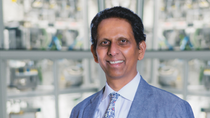Media
Industrial Formulators: the chemistry of the unseen

Padma Prabodh Varanasi, Ph.D., leads the Application Technology and Tech Service group in Wyandotte, Michigan.
Chemistry can often feel complex and difficult to understand. A product includes many different ingredients that interact with each other, so it can often be unclear which ingredient does what. A big part of many products in households and industries today involves formulations.
Formulations contain ingredients that do not chemically react with one another but can help a product bring out specific results when combined. However, finding the right combination of ingredients and the best way to apply the formulation can be extremely challenging.
At BASF, the job of finding the right ingredients and enhancing the performance of our customer’s products is in the hands of Padma Prabodh Varanasi, Ph.D., and his team.
What industrial formulators are all about
The industrial formulators business in the Care Chemicals division at BASF develops and tests products in several different industries, from coatings to construction, crop protection, plant nutrition, and animal health, among others.
Formulators help alter the properties of substances “without changing the composition of the material,” explains Varanasi. For example, they can help control the amount of foam generated by a detergent or they can help cement keep a certain consistency, making sure it doesn’t dry too quickly.
Chelates, for example, are ingredients that can bind metal ions like calcium or magnesium ions, which can often be found in hard water, and keep them from forming deposits on process equipment. BASF’s chelates are normally part of dishwasher tabs, detergents, and micronutrients for crops.
Another example of the type of formulators that BASF provides to its customers is the raw materials for making binders in paints. Household paints have pigments and a binder, which connects the particles together and helps keep paint on the walls. These raw materials can be organic or made out of other materials.
A chemical engineer in search of answers
Born and raised in India, Varanasi studied chemical engineering just like his father and brother did and decided to come to America in pursuit of his Ph.D. and was able to study under renowned professionals in the field, including the late emeritus professor, Eli Ruckenstein.
He has been at BASF for 11 years, and during this time he has been in charge of several research and development groups, including the group involved in the development of a polymer called Sokalan HP20 for laundry applications which was selected as the winner of the BASF Innovation award, the highest honor BASF grants innovative initiatives.
Curiosity and a clear sense of the physics of the problem, as Varanasi puts it, are key motivators for him and his team. In order to find the right application for an unmet need of a customer, it’s key “to have a fundamental understanding of the science behind that need. What does this mean scientifically? And then, once you understand that, you can think of the suitable chemistry to address the parameters identified,” he explains.
This same drive to find a deeper understanding is what has led Varanasi, in his more than 35 years of experience, to participate in 30 research publications and presentations in international journals and in 100 patent applications in the U.S. and abroad.
His professional achievements have also led him to receive the 2022 Samuel Rosen Memorial Award from the American Oil Chemists Society’s (AOCS) Surfactants and Detergents division for his contributions to the field of surfactants (substances that reduce surface tension and increase the ability to spread, for example, detergents).
The challenges of finding the right solution
One of the biggest challenges Varanasi’s team faces is that every formulation needs to produce measurable, objective effects. For example, does formulation "X" actually help kill weeds? How many cracks does cement get with the "Y" formulation? How does this compare to others in the market?
There is no room for subjectivity or perception and results cannot be associated with how a group of people feels about the product.
If BASF’s current technologies can meet this need, then the process becomes much easier. If not, understanding the physics of the problem paints a much clearer picture of the path forward.
Testing can also be difficult when it comes to industrial products because they need to be tested on a much larger scale and mimicking the process in BASF’s U.S. lab isn’t always possible. For this reason, Varanasi has a close relationship with universities and external specialized labs that can help accelerate the development process.
Collaboration and frequent interactions with BASF labs from other regions are also essential to accelerate the process, not only in terms of testing and data collection but to exchange ideas and share useful practices. By doing this, they can also avoid spending time on products that have already been developed.
New formulations and applications are discovered every day, and scientists like Prabodh Varanasi are key to driving innovation and change within BASF and in different industries.
Yet, despite all of his achievements, he is far from done yet. In his words, “I still have a lot of passion and a desire to make useful scientific discoveries in which I have a clear understanding of every aspect involved.”
More information
For questions, please contact mariana.licio@basf.com
For media inquiries, please contact molly.birman@basf.com